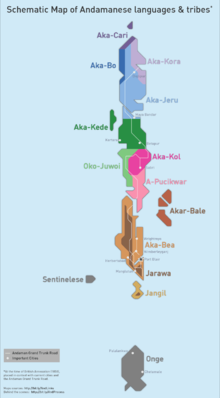Aka-Jeru language
| Jeru | |
|---|---|
| Aka-Jeru | |
| Native to | India |
| Region | Andaman Islands; interior and south North Andaman island, Sound island. |
| Extinct | 2009 |
|
Great Andamanese
|
|
| Language codes | |
| ISO 639-3 | Either: akj – Aka-Jeru gac – Great Andamanese creole |
| Glottolog |
akaj1239 (Aka-Jeru)
|
 |
|
The Jeru language, Aka-Jeru (also known as Yerawa, not to be confused with Järawa), is a Great Andamanese language, of the Northern group. Jeru was spoken in the interior and south coast of North Andaman and on Sound Island.
As the numbers of Great Andamanese progressively declined over the succeeding decades, the various Great Andamanese tribes either disappeared altogether or became amalgamated through intermarriage. By 1994, the 38 remaining Great Andamanese who could trace their ancestry and culture back to the original tribes belonged to only three of them (Jeru, Bo, and Cari).
Whether the resulting Great Andamanese language was Jeru or a creole based on several languages, of which Jeru was a primary component, the last fluent speaker died in 2009.
The Great Andamanese languages are agglutinative languages, with an extensive prefix and suffix system. They have a distinctive noun class system based largely on body parts, in which every noun and adjective may take a prefix according to which body part it is associated with (on the basis of shape, or functional association). Thus, for instance, the *aka- at the beginning of the language names is a prefix for objects related to the tongue. An adjectival example can be given by the various forms of yop, "pliable, soft", in Aka-Bea:
Similarly, beri-nga "good" yields:
The prefixes are,
Body parts are inalienably possessed, requiring a possessive adjective prefix to complete them, so one cannot say "head" alone, but only "my, or his, or your, etc. head".
...
Wikipedia
